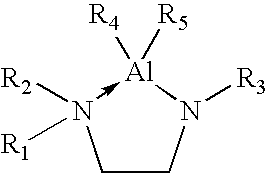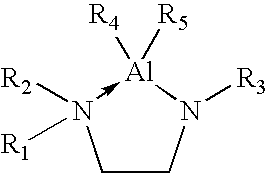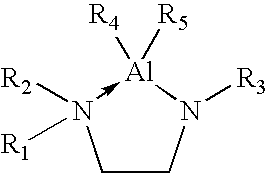Organoaluminum precursor compounds
a technology of precursor compounds and aluminum, applied in the field of organic aluminum precursor compounds, can solve the problems of low stability, high viscosity, low vapor pressure, and high cost of aluminum precursors for chemical vapor deposition, and achieves the effects of low viscosity, long shelf life, and easy us
- Summary
- Abstract
- Description
- Claims
- Application Information
AI Technical Summary
Benefits of technology
Problems solved by technology
Method used
Image
Examples
example 1
Synthesis of Dimethylethyl Ethylenediamine Dimethylaluminum (DMEEDDMA)
[0073] Under an inert atmosphere of nitrogen, 5 milliliters of trimethylaluminum in 30 milliliters of anhydrous toluene was cooled to 0° C. To this solution was added, drop wise, 8.5 milliliters of dimethylethylethylenediamine. The reaction was heated to reflux for 2 hours and stirred at room temperature for 12 more hours. The solvent was removed under reduced pressure and the remaining product distilled under reduced pressure. The light cuts from the distillation were discarded leaving only pure DMEEDDMA.
example 2
Alternate Synthesis of DMEEDDMA
[0074] Under an inert atmosphere of nitrogen, 22 milliliters of dimethylethylethylenediamine in 250 milliliters of hexanes was cooled to 0° C. 51 milliliters of n-butyllithium was added to the solution in a drop wise manner. The solution was allowed to warm to room temperature and stirred for 12 hours yielding a yellow liquid and colorless solid. This solution was again cooled to 0° C. and 9 milliliters of Me2AlCl was added drop wise. The solution was allowed to warm to room temperature and stirred for 16 hours. The solid was removed from the solution via filtration and solvent removed under reduced pressure. An NMR of the solution showed DMEEDDMA along with impurities.
example 3
Thermal stability of DMEEDDMA
[0075] The thermal stability of DMEEDDMA was evaluated by exposing a silicon wafer to a mixture containing only argon and DMEEDDMA vapors at approximately 330° C. The DMEEDDMA was evaporated at 40° C., using 100 standard cubic centimeters of argon. The DMEEDDMA vaporizer was maintained at 50 Torr, using a needle valve between the vaporizer and the deposition reactor. The equipment used in this experiment is described in J. Atwood, D. C. Hoth, D. A. Moreno, C. A. Hoover, S. H. Meiere, D. M. Thompson, G. B. Piotrowski, M. M. Litwin, J. Peck, Electrochemical Society Proceedings 2003-08, (2003) 847. The deposition reactor was maintained at 5 Torr. The material exiting the DMEEDDMA vaporizer was combined with an additional 360 standard cubic centimeters of argon (i.e. total flow of mixture was 460 standard cubic centimeters) prior to wafer exposure. No material was deposited after the wafer was exposed to this mixture for 15 minutes. This indicates that the...
PUM
| Property | Measurement | Unit |
|---|---|---|
| temperature | aaaaa | aaaaa |
| temperature | aaaaa | aaaaa |
| temperature | aaaaa | aaaaa |
Abstract
Description
Claims
Application Information
 Login to View More
Login to View More - R&D
- Intellectual Property
- Life Sciences
- Materials
- Tech Scout
- Unparalleled Data Quality
- Higher Quality Content
- 60% Fewer Hallucinations
Browse by: Latest US Patents, China's latest patents, Technical Efficacy Thesaurus, Application Domain, Technology Topic, Popular Technical Reports.
© 2025 PatSnap. All rights reserved.Legal|Privacy policy|Modern Slavery Act Transparency Statement|Sitemap|About US| Contact US: help@patsnap.com



